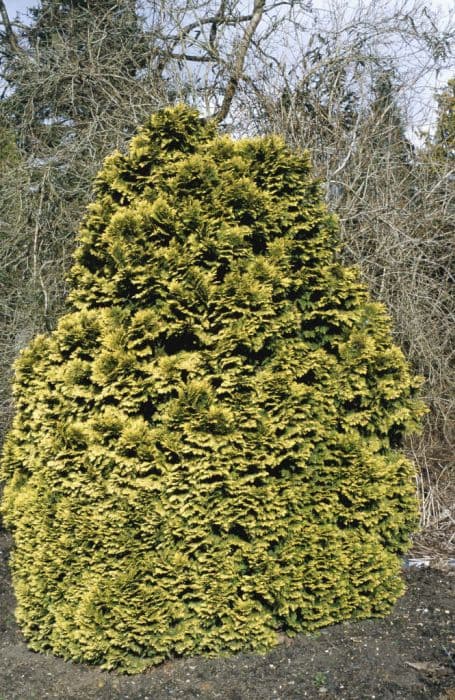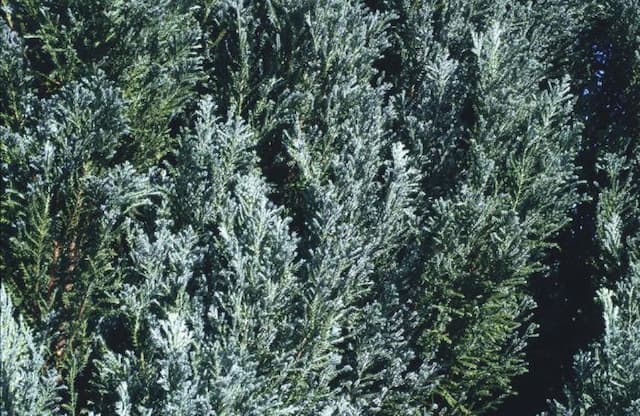Tsatsumi Gold Hinoki Cypress Chamaecyparis obtusa 'Tsatsumi Gold'

ABOUT
The 'Tsatsumi Gold' is an ornamental conifer that is admired for its visually striking foliage. This plant has a unique appearance, thanks to the golden-yellow tips of its leaves, which stand out against the deeper green hues of the inner foliage. The leaves themselves are scaled, often overlapping each other closely, giving the plant a dense, textured look. The golden color of the new growth is most intense during the spring and early summer, providing a bright and cheerful display. As the seasons change, the golden hue can become more muted, blending into a richer green that maintains the plant's appeal year-round. This variety has a growth habit that is somewhat irregular, often described as a combination of both vertical and lateral growth, which contributes to its overall sculptural quality. The foliage is soft to the touch, which contrasts with the more prickly texture that some other conifers have. Due to its distinctive color and form, 'Tsatsumi Gold' is often used in landscaping as a focal point or as part of a grouping for a striking visual effect. It is a slow-growing plant that maintains a manageable size for many years, making it an excellent choice for both gardens and decorative containers.
About this plant
 Names
NamesFamily
Cupressaceae
Synonyms
Tsatsumi Gold Hinoki Cypress, Tsatsumi Gold Cypress
Common names
Chamaecyparis obtusa 'Tsatsumi Gold'.
 Toxicity
ToxicityTo humans
The plant commonly known as Hinoki cypress (Chamaecyparis obtusa) 'Tsatsumi Gold' is not known to be toxic to humans. Generally, it does not cause poisoning if touched or ingested. However, as with many plants, individuals with specific allergies or sensitivities may experience discomfort or allergic reactions. Ingesting plant parts is not advisable, but there typically are no severe consequences reported for this species.
To pets
The Hinoki cypress is also not known to be toxic to pets. It should not cause any significant symptoms of poisoning in animals such as dogs and cats if they happen to ingest it. However, ingestion of non-food items can potentially lead to gastrointestinal upset or blockage, so it is still best to prevent pets from consuming plant material.
 Characteristics
CharacteristicsLife cycle
Perennials
Foliage type
Evergreen
Color of leaves
Gold
Height
3-4 feet [0.91-1.22 meters]
Spread
2-3 feet [0.61-0.91 meters]
Plant type
Tree
Hardiness zones
5-8
Native area
Japan
Benefits
 General Benefits
General Benefits- Aesthetic Appeal: Adds visual interest to gardens with its unique golden-yellow foliage and conical shape.
- Low Maintenance: Requires minimal care once established, making it ideal for busy gardeners or those new to gardening.
- Year-Round Interest: Evergreen nature ensures that the garden remains vibrant even during the colder months.
- Drought Tolerant: Once established, it can withstand periods of drought, reducing the need for frequent watering.
- Wildlife Habitat: Provides shelter and nesting sites for birds, contributing to biodiversity.
- Compact Size: Its small stature makes it suitable for gardens with limited space or for container planting.
- Versatile Landscaping: Can be used in a variety of garden styles, including formal, Japanese, and rock gardens.
 Medical Properties
Medical PropertiesThis plant is not used for medical purposes.
 Air-purifying Qualities
Air-purifying QualitiesThis plant is not specifically known for air purifying qualities.
 Other Uses
Other Uses- Hinoki Cypress's fine grain and high oil content make it a popular choice for crafting precision instruments such as violins and other stringed instruments.
- The aromatic wood of Hinoki Cypress can be used in the construction of saunas for its scent and resistance to humidity.
- In model making, Hinoki wood's smooth texture and workability make it ideal for creating detailed and high-quality models or miniatures.
- Woodworkers value Hinoki for creating intricate joinery in furniture, showcasing the wood's natural beauty and fine texture.
- Hinoki wood shavings and sawdust are often utilized in smoking foods, giving them a unique flavor profile.
- The bark of Hinoki Cypress can be used in garden mulches, providing a natural pest deterrent due to its aromatic properties.
- Used in traditional Japanese ceremonies, Hinoki Cypress branches may be incorporated in decorative displays or as a symbol of purity.
- As a natural insect repellent, the essential oil derived from Hinoki can be used in creating natural insect repelling sprays or candles.
- The dense wood of Hinoki Cypress can be carved into intricate sculptures and art pieces, often seen in traditional Japanese art.
- When dried and processed, Hinoki Cypress needles can be used to create a subtly scented bedding for small pets.
Interesting Facts
 Feng Shui
Feng ShuiThe Hinoki cypress is not used in Feng Shui practice.
 Zodiac Sign Compitability
Zodiac Sign CompitabilityThe Hinoki cypress is not used in astrology practice.
 Plant Symbolism
Plant Symbolism- Longevity: The Chamaecyparis obtusa, commonly known as Hinoki Cypress, is a slow-growing tree that can live for hundreds of years, symbolizing long life and endurance.
- Peace: The Hinoki Cypress has a calming presence and a soothing scent, often associated with tranquility and peace.
- Sacredness: In Japan, where the Hinoki Cypress is native, it is considered sacred and is used in the construction of temples and shrines, representing purity and sacredness.
- Resilience: With its ability to withstand various climates and conditions, the Hinoki Cypress symbolizes resilience and adaptability.
- Beauty: The 'Tsatsumi Gold' variety, with its golden foliage, adds a layer of beauty to its symbolism, often representing aesthetic and ornamental value.
 Water
WaterHinoki cypress should be watered deeply and thoroughly, ensuring the root zone is moist. It's best to water when the topsoil feels dry to the touch, generally about once a week, but this can vary depending on climate and soil conditions. During the growing season, watering may be more frequent, whereas in winter, it should be reduced. An average recommendation would be to provide approximately 1 to 1.5 gallons of water every week during active growth periods. Be cautious not to overwater, as Hinoki cypress does not like soggy soil.
 Light
LightHinoki cypress thrives in full sun to partial shade. It prefers a spot that receives at least four to six hours of direct sunlight daily, but it can also tolerate some light shade. Avoid deep shade, as it can lead to sparse foliage and poor growth.
 Temperature
TemperatureHinoki cypress is hardy and can withstand a range of temperatures. It can survive minimum temperatures down to about 20°F and can handle maximum temperatures well into 90°F. The ideal temperature range for optimal growth is between 60°F and 80°F.
 Pruning
PruningPrune Hinoki cypress to maintain its shape and health; it's typically best done in the late winter or early spring before new growth begins. Remove any dead or diseased branches, and thin out crowded areas to improve air circulation. Pruning can be done annually or as needed to shape the plant or control its size.
 Cleaning
CleaningAs needed
 Soil
SoilThe Hinoki cypress 'Tsatsumi Gold' prefers a well-draining soil mix with equal parts of peat, loam, and sharp sand. It thrives best at a soil pH of 5.0 to 6.0, which is slightly acidic to neutral.
 Repotting
RepottingHinoki cypress 'Tsatsumi Gold' should be repotted every 2 to 3 years to refresh the soil and facilitate healthy growth. Younger plants may require more frequent repotting.
 Humidity & Misting
Humidity & MistingHinoki cypress 'Tsatsumi Gold' enjoys moderate to high humidity levels but can tolerate a range of humidity conditions, making it adaptable to many environments.
 Suitable locations
Suitable locationsIndoor
Place in a bright spot, avoid heat sources and provide humidity.
Outdoor
Plant in well-draining soil, full sun to partial shade.
Hardiness zone
5-8 USDA
 Life cycle
Life cycleThe life of 'Tsatsumi Gold' Hinoki Cypress (Chamaecyparis obtusa 'Tsatsumi Gold') begins with seed germination, generally requiring a period of stratification to overcome dormancy. Once germinated, the seedling undergoes a juvenile phase where it establishes roots and foliage, gradually developing the characteristic dense, fan-like sprays of golden-yellow foliage. As it enters the vegetative growth stage, 'Tsatsumi Gold' continues to grow in height and spread, forming an evergreen, conical to pyramidal shape that is prized in landscapes. During maturity, the plant produces small, globular cones which mature to release seeds, thus continuing the reproductive cycle. The Hinoki Cypress is a slow-growing plant, and 'Tsatsumi Gold' may live for several decades, with mature specimens typically reaching up to 3-6 feet tall. Throughout its life, the plant requires well-drained soil, partial to full sunlight, and regular watering to maintain its health and vitality.
 Propogation
PropogationPropogation time
Spring-Early Summer
The Hinoki cypress 'Tsatsumi Gold,' a popular ornamental conifer for its golden-yellow foliage, is typically propagated via semi-hardwood cuttings. This method is usually conducted in late summer to early fall, when the new growth has begun to mature and harden slightly. To propagate, cuttings about 4 to 6 inches long are taken from the current year’s growth. The leaves are removed from the lower two-thirds of the cutting, and the cut end is often treated with a rooting hormone to encourage root development. The prepared cutting is then inserted into a rooting medium, typically a mixture of peat and perlite or sand, ensuring that the environment remains humid and warm, but not too wet, to prevent rot. Once the cuttings have rooted, which can take several weeks to a few months, they can be transplanted into individual pots.









